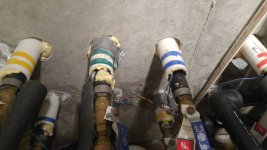I installed a 4-ton unit in my house, which is 1250 sq ft x2 because of full basement.
House was built in the 80's, and as such only has 2x4 walls and R13. Basement is poured walls and I am sure no insulation outside either. Especially since the band board/ perimeter (that little cavity between floor joists on top of the wall)....none of them were even insulated. Which they are now.
Doing a rough load loss calculation based on all that, windows, doors, etc.....using numbers and formulas, and calculators attained online, With 0*F weather outside and a 72* inside temp...I was coming up with a load loss of ~45k BTU
So I settled in on a 4-ton system. And being two-stage.....even if I oversize.....the inefficiencies of doing so are mitigated by running primarily on stage 1.
And the cold spells we have had.....10 days in a row of below zero nights and single digit days......first stage would run for ~1hr...then second stage would kick in and be done in 15-20 min everytime.
So in hindsight.....probably could have gotten by with a 3-ton......but I for darn sure didnt want to be undersized and have to rely on fixing a fire, or turning on my baseboards for backup. So I would have rather err'd on the high side.
Now that said......for my soil type......600' loop per ton is what was called for if going horizontal loops as I did. But the cost of a continuous 600' roll of pipe vs 800' loop was very little. Dont remember exacts....but something like ~$130 for 600' vs $160 for 800'. So I choose to go 800'. So with 4 loops on a 4 ton system....I actually have 5-ton's of ground loop capacity. All the while heating a house that really would probably be fine on 3-ton.
So in the even that I ever have a leaking loop and have to shut it down.....I am not concerned at all.
We have a 48 kBTU system for a 2700 sq. ft house. Single geo unit with a zone controller, duct dampers, and ECM blower.
If I could do it again, I would increase the size of the ground loop so that I'd have more capacity for extreme cold weather. With two stages and an ECM blower, the system could certainly be run at lower capacity in summer so that it could still give the right mix of cooling and dehumidification. But I am clearly limited by ground loop low temperature limits in real cold weather, and the easy way to eliminate that is more ground loop capacity.
I don't know if we will have another serious cold snap this winter, but if so I plan to monitor entering/leaving water temps and see how the system does with long run times in 1st and 2nd stage.
The way my system is setup, the single geo unit handles two zones via a zone controller, duct dampers, and staging. I have it setup to run at stage 1 whenever a single zone calls for heat/cool, or go to stage 2 if both zones call for heat/cool. If in heat mode and it's run at stage 2 for a certain amount of time (which I can set) then it turns on aux heat (stage 3). In reality, that time limit should change based on outdoor temperature, becoming longer at higher temps and perhaps skipping stage 3 all together above about 25F. I can add an outdoor temp sensor and use that to disable aux heat above a certain temp, which I may do.
Another option is to tell the zone controller to let the thermostats control staging, which they would do based on runtime (typically upstaging after 9-10 minutes for this type of system), but I don't like this as it could initially be running both zones at stage 1 for that time, and in cold weather, or summer heat, that is not enough heat/cool and airflow for two zones.
Anyhow, I will probably start a new thread about this when I get to measuring performance and setting the staging, as I will want input from folks like you. With this setup, it seems like the staging logic and scheduling has a big effect on performance and electricity use.

